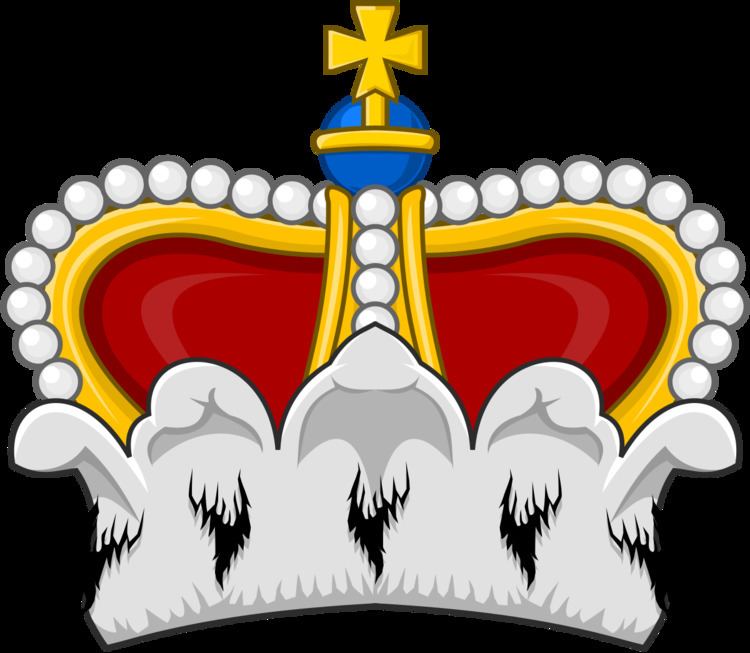 | ||
A marquess ( /ˈmɑːrkwɪs/; French: marquis, [mɑʁki]; Spanish: marqués, Portuguese: marquês) is a nobleman of hereditary rank in various European peerages and in those of some of their former colonies. The term is also used to translate equivalent Asian styles, as in imperial China and Japan.
Contents
- Etymology
- Title in the United Kingdom
- Marquesal titles in other European languages
- Baltic languages
- Finno Ugric languages
- Germanic languages
- Romance languages
- Slavic languages
- Other languages
- Equivalent non Western titles
- References
In Great Britain and Ireland, the correct spelling of the aristocratic title of this rank is marquess (although for aristocratic titles on the European mainland, the French spelling of marquis is often used in English). In Scotland the French spelling is also sometimes used. In Great Britain and Ireland, the title ranks below a duke and above an earl (see "Marquesses in the United Kingdom"). A woman with the rank of a marquess, or the wife of a marquess, is called a marchioness /ˌmɑːrʃəˈnɛs/ in Great Britain and Ireland or a marquise /mɑːrˈkiːz/ elsewhere in Europe. The dignity, rank or position of the title is referred to as a marquisate or marquessate.
The theoretical distinction between a marquess and other titles has, since the Middle Ages, faded into obscurity. In times past, the distinction between a count and a marquess was that the land of a marquess, called a march, was on the border of the country, while a count's land, called a county, often was not. As a result of this, a marquess was trusted to defend and fortify against potentially hostile neighbours and was thus more important and ranked higher than a count. The title is ranked below that of a duke, which was often restricted to the royal family and those that were held in high enough esteem to be granted such a title.
In the German lands, a Margrave was a ruler of an immediate Imperial territory (examples include the Margrave of Brandenburg, the Margrave of Baden and the Margrave of Bayreuth), not simply a nobleman like a marquess or marquis in Western and Southern Europe. German rulers did not confer the title of marquis; holders of marquisates in Central Europe were largely associated with the Italian and Spanish crowns.
Etymology
The word entered the English language from the Old French marchis ("ruler of a border area") in the late 13th or early 14th century. The French word was derived from marche ("frontier"), itself descended from the Middle Latin marca ("frontier"), from which the modern English words "march" and "mark" also descend. The distinction between governors of frontier territories and interior territories was made as early as the founding of the Roman Empire when some provinces were set aside for administration by the senate and more unpacified or vulnerable provinces were administered by the emperor. The titles "duke" and "count" were similarly distinguished as ranks in the late empire, with dux (literally, "leader") being used for a provincial military governor and the rank of comes (literally "companion," that is, of the Emperor) given to the leader of an active army along the frontier.
Title in the United Kingdom
In Great Britain and Ireland, the correct spelling for an English aristocrat of this rank is marquess. The word "marquess" is unusual in English, ending in "-ess" but referring to a male and not a female. A woman with the rank of a marquess, or the wife of a marquess, is called a marchioness in Great Britain and Ireland, or a marquise /mɑːrˈkiːz/ elsewhere in Europe. The dignity, rank or position of the title is referred to as a marquisate or marquessate.
The honorific prefix "The Most Honourable" is a form of address that precedes the name of a marquess or marchioness in the United Kingdom.
The rank of marquess was a relatively late introduction to the British peerage: no marcher lords had the rank of marquess, though some were earls. On the evening of the Coronation of Queen Victoria in 1838, the Prime Minister Lord Melbourne explained to her why (from her journals):
"I spoke to Ld M. about the numbers of Peers present at the Coronation, & he said it was quite unprecedented. I observed that there were very few Viscounts, to which he replied "There are very few Viscounts," that they were an old sort of title & not really English; that they came from Vice-Comites; that Dukes & Barons were the only real English titles; — that Marquises were likewise not English, & that people were mere made Marquises, when it was not wished that they should be made Dukes".
Marquesal titles in other European languages
The following list may still be incomplete. Feminine forms follow after a slash; many languages have two words, one for the "modern" marquess and one for the original margrave.In Italy the equivalent modern rank (as opposed to margravio) is that of marchese, the wife of whom is a marchesa, a good example of how several languages adopted a new word derived from marquis for the modern style, thus distinguishing it from the old "military" margraves. Even where neither title was ever used domestically, such duplication to describe foreign titles can exist.
Baltic languages
Finno-Ugric languages
Germanic languages
Romance languages
Slavic languages
Other languages
Equivalent non-Western titles
Like other major Western noble titles, marquess or marquis is sometimes used to render certain titles in non-Western languages with their own traditions, even though they are, as a rule, historically unrelated and thus hard to compare. However, they are considered "equivalent" in relative rank.
This is the case with:
